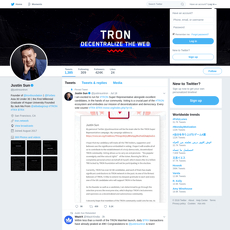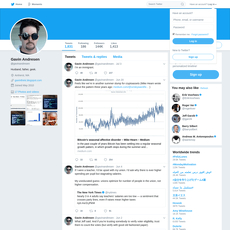The Crypto Dog Review
The Crypto Dog
twitter.com
The Crypto Dog Review Guide: What to Expect from @TheCryptoDog (Everything You Need to Know + FAQ)
Curious whether following The Crypto Dog will actually help your trading—or just add more noise to your feed?
If you’ve ever opened X/Twitter during a volatile session, you know the feeling: quotes flying, charts stacked, memes everywhere, and confidence levels swinging with every candle. Some accounts sharpen your edge. Others push you into FOMO, confusion, or worse—bad trades you didn’t plan.
The point of following top voices isn’t to copy trades—it’s to sharpen your filters.
In this review, I unpack what you really get by following The Crypto Dog, how to use his content without wrecking your risk, and where beginners and pros alike can squeeze value. If you want less hype, fewer unforced errors, and a clearer way to learn from big accounts, you’re in the right place.
Why Crypto Twitter can mess with your plan
Crypto Twitter is a firehose. It’s fast, loud, and often right and wrong at the same time. The risk isn’t just bad information—it’s the way your brain reacts to it.
- Signal overload: Hundreds of takes per hour. Your attention gets yanked from your plan to someone else’s conviction.
- Hidden incentives: Some voices trade around what they post. Others have sponsors or bags. Not all incentives are aligned with you.
- Hype cycles: The same coin can be “dead” in the morning and “generational” by night. It’s hard to keep a steady view.
- Timing traps: Good analysis posted late can be worse than no analysis. Entries and invalidations matter more than opinions.
Here’s the classic 3-minute FOMO spiral:
- You see a high-conviction post with a clean chart.
- You buy a breakout that already ran 15% because “it’s going to 10x.”
- Price snaps back to the mean, your stop wasn’t planned, you exit in pain—then watch it grind higher without you.
This isn’t just anecdotal. A few useful findings from behavioral and market research:
- Research on Twitter mood and markets shows social sentiment can influence short-term moves—great for context, dangerous if you chase.
- Barber & Odean’s work on individual investors shows overtrading tends to harm performance—attention-grabbing ideas make us trade too often.
- Studies linking search interest and Bitcoin suggest attention spikes correlate with volatility—exactly when CT gets the loudest.
Point is: even great accounts can nudge you into bad timing if you don’t set guardrails. That’s why this review focuses on how to extract the right kind of value from The Crypto Dog’s feed.
What I’ll do for you here
I’m going to break down what The Crypto Dog actually posts, how reliable it tends to be, and how to use his viewpoints as inputs—not orders. I’ll show simple ways to reduce noise (lists, notifications, bookmarks) and give you the questions I use to check any influencer’s claim. I’ll also answer the common stuff you search—“Is he legit?”, “Does he share entries?”, “Does he sell signals?”—with straight talk.
What you’ll learn
- Content style: What shows up on his feed and how to interpret it fast.
- Strengths and blind spots: Where his perspective shines—and where you should add a second opinion.
- Verification tips: Simple ways to check context, timing, and past calls without getting lost.
- Practical usage: How to set notifications and lists, when to pay attention, and when to ignore the noise.
- Beginner guidance: How to learn from his frameworks without copy-trading yourself into trouble.
Who this is for
- Active traders who want market color and sentiment reads without derailing their setups.
- Long-term investors who use X/Twitter as a scanner for narratives, catalysts, and risk-on/off vibes.
- Crypto-curious learners who want to upgrade their filters and avoid the common FOMO traps.
If you want fewer regret trades and a smarter way to learn from big accounts like @TheCryptoDog, keep going—next up, I’ll answer the question everyone asks first: who is he really, and why do so many traders care what he posts?
Who is The Crypto Dog? Background, brand, and why people follow him
The Crypto Dog is one of those rare X/Twitter presences who’s been around long enough to earn “seen a few cycles” status. He built a brand on consistent market commentary, chart snapshots that cut the fluff, and a tone that feels more like a level-headed trading buddy than a hype machine. In a space known for loud takes and short memories, that balance is exactly why people keep him on their feeds.
The persona and platform(s)
His home base is X/Twitter at https://twitter.com/TheCryptoDog. That’s where you’ll see the real-time action: quick charts, market reads, and short threads when the market needs a clearer narrative. He’ll jump into replies, riff on meme culture when it fits the moment, and drop the occasional higher-timeframe view that helps reframe the noise.
- Voice/tone: straight to the point, grounded, occasionally witty. No theatrics, no endless threads for the sake of it.
- Format: concise charts with levels, one-liners that define scenarios (e.g., “Above X = momentum, below Y = chop”), and short lessons embedded in market commentary.
- Presence: primarily X/Twitter; you’ll often see him engage with other credible traders and analysts during volatile windows.
“Process beats prediction.”
That line isn’t a slogan—it’s the vibe. He posts in a way that nudges you to think about process, not just outcomes.
What he’s known for
Followers come for the blend of trading insight and practicality. You’ll see:
- Market commentary: quick reads on where momentum is likely to shift and why sentiment matters right now.
- Charts/TA snapshots: clean levels, structure, and scenario planning rather than hero calls.
- Narrative framing: how funding, open interest, or macro headlines might feed into the next move—useful context without the fearmongering.
- Education-by-osmosis: you pick up frameworks by reading—how to think in probabilities, where invalidation lives, and how sentiment flips.
- Light meme energy: just enough to keep morale up when candles get unforgiving.
It’s not a signals page. It’s a running trading journal you can learn from in public—something research on financial social media consistently finds useful when it biases toward reasoning over predictions.
Who his content serves best
Not every account fits every reader. His feed tends to click for:
- Active traders: if you map his levels to your own system, you’ll get timely context for entries, adds, or de-risking.
- Crypto natives: people who already speak “funding/oi/liquidity” and want a sanity check on market structure.
- Serious learners: if you’re early but willing to focus on why a view makes sense (not copy-trading the view), the repetition of good habits compounds.
Worth noting: studies on retail behavior and copy-trading show that blindly mirroring Internet trades underperforms having a predefined plan. If you treat his posts as inputs for your own rules, you’re aligned with how his content works best.
What makes him stand out
Plenty of big accounts talk loud. This one earns attention differently:
- Longevity: he’s posted through multiple bull/bear regimes. That shows up as humility and scenario thinking instead of certainty theater.
- Balanced tone: fewer “we’re all gonna make it tomorrow” calls, more “here’s the path if the level holds, here’s the invalidation if it doesn’t.”
- Market structure focus: clean, repeatable levels; trend, range, and liquidity thinking; sentiment reads when headlines overpower charts.
- Signal-first posting: when volatility hits, he trims the fat. You get the two lines that matter and the sentence that explains them.
In a feed that often feels like a casino pit, seeing clear levels with a calm read is a relief. It’s not just what he says—it’s how consistently he says it under pressure.
Curious what you’ll actually see in your timeline if you hit Follow—how often he posts, which threads are worth saving, and when notifications make sense? Let’s unpack the day-to-day signal next so you can use his feed like a pro.
What you actually get by following @TheCryptoDog
If you want a fast, readable feed that helps you read the room without turning you into a copy-trader, @TheCryptoDog delivers. Think quick market color, clean levels, and “this is what matters today” context—sprinkled with memes to capture sentiment in one glance.
“Absorb the idea, not the impulse.”
Core content types
- Market updates (intraday and daily) — Short posts like “trend intact while above X,” or “range until acceptance above Y.” Useful when you need a directional anchor without scrolling endless threads. Expect a bias, a key level, and a quick why.
- Charts and TA snapshots — Clean charts highlighting ranges, trendlines, liquidity pools, and invalidation zones. You’ll see timeframes like 1H/4H/D, not five indicators fighting each other. Example vibe: “BTC holding above prior breakout; continuation likely unless reclaimed by sellers.” Screenshot-based charts keep it scannable.
- Narrative takes — Notes on what’s rotating and why: L2s heating up, AI beta vs. majors, restaking/regulatory chatter, ETH/BTC dominance shifts. These aren’t hype bombs—they’re “watch this pocket of risk” nudges that help you prep your watchlist.
- Sentiment reads — Mentions of funding, open interest, and crowded positioning. When perps are stretched, expect reminders to scale risk. This lines up with research showing social-media mood and positioning often foreshadow short-term volatility in crypto-heavy retail markets.
- Occasional meme culture — Not throwaway noise. Memes double as a pulse check: are we euphoric, nihilistic, or apathetic? Sentiment often peaks at punchline-level absurdity—use it as a contrarian ping, not a trade trigger.
- Educational threads — Framework-style posts: how to think about ranges vs. trends, where invalidation lives, why patience beats FOMO. Bookmark material. It’s less “system rules,” more “how experienced traders actually frame the day.”
Tip: If a post gives you a level, a condition, and an invalidation, that’s study-worthy. If it’s just a joke or a one-word bias, treat it as sentiment—not a plan.
Posting cadence and timing
He shows up when it matters. Expect more activity around volatility and key catalysts, and less hand-holding when the market’s chopping.
- Volatility windows — He’s typically active into/through big catalysts: CPI/FOMC, ETF headlines, large liquidation cascades, and strong trend days. You’ll often get a pre-event framing (“levels that matter”) and a post-event sanity check.
- Session rhythm — Posts tend to cluster around high-participation hours, especially the U.S. morning (around 13:30–15:30 UTC) and into New York close when flows rebalance. Asia session get more concise notes unless something’s ripping.
- Weekends — Quick checks, memes, and caution flags. Crypto’s weekend liquidity is thin; if he’s emphasizing patience, that’s a hint to scale risk or stick to spot.
Smart cadence playbook
- Turn on notifications during event-heavy weeks (CPI/FOMC, major ETF flows, obvious trend days).
- Keep him in a “Research” list for range-bound, low-volatility weeks to avoid overtrading noise.
- Skim early U.S. hours for “what matters today” framing; revisit near NY close for risk resets.
Signal vs. noise
Not every post is a trade idea—and that’s a feature, not a bug. Here’s how I separate quick color from real signal:
- Signal — Chart + level + condition (e.g., “acceptance above,” “rejection at,” “invalid if”). Bookmark these. If a thread explains a setup or a narrative rotation with clear risk lines, it’s study gold.
- Context — One-liners about sentiment, funding, or “don’t chase” warnings. Use them as guardrails, especially when you feel FOMO creeping in.
- Noise (for trading, not for mood) — Pure memes or victory laps. Entertaining and sentiment-rich, but not entry/exit material.
Bookmark hack for X:
- Save “framework” threads and chart posts that include invalidation.
- Use X search: from: TheCryptoDog keyword to resurface older context when a narrative returns.
- Screenshot key charts into your journal and write your own plan next to them—what would make you act, and why?
Why this matters: multiple studies have shown that social-media mood and attention can amplify short-term price swings. If you only react to the loudest posts, you’re statistically stepping into crowd risk. Filtering for posts with conditions and invalidation keeps you on the right side of probabilities.
What he rarely does
- Exact “buy here, sell there” signals — You’ll get levels and logic, not signals. That’s intentional. The value is in the framework; the execution is on you.
- Hand-holding — Don’t expect constant reminders or PnL streams. You’re meant to think, not mirror.
- Undisclosed shill storms — You won’t see a flood of micro-cap promos. Still, treat any ticker mention as opinion and verify disclosures before acting.
- 24/7 feed — If the market’s choppy or nothing’s changed, he won’t post just to post. Silence can be a signal to sit on your hands.
If you can spot the difference between entertainment, sentiment, and a real setup, you’ll squeeze far more value from his feed than the average follower. But the next question is the one that actually protects your stack: how much of this is trustworthy, and how should you verify it without falling for cherry-picked wins? Let’s test that next.
Credibility check: track record, transparency, and how to verify
Trust is earned on X/Twitter the same way it’s earned in the market: by showing up across cycles, owning the misses, and letting the receipts speak. That’s how I look at any big crypto voice, including The Crypto Dog.
“Trust, but verify.” — the only sane way to consume crypto Twitter.
Longevity matters
Being active through multiple cycles is a strong signal. It doesn’t make anyone a prophet, but it filters out the one-season wonders who nail a few calls and disappear.
- Multiple cycle presence: Look for commentary that spans the 2017 mania, the 2018–2019 winter, the 2020–2021 run, the 2022 drawdown, and the latest uptrend. Accounts that have posted consistently across those regimes tend to build humility and process.
- Consistency of voice: Is the tone relatively even in euphoria and fear? You want less “all-in” energy at tops and less despair at bottoms. That emotional balance is a quiet edge.
- Behavior in chop: Real traders throttle risk when the tape gets noisy. Watch for posts that acknowledge uncertainty and step back during low-quality conditions. That’s a green flag.
There’s a reason seasoned accounts stick around. As Barber and Odean’s famous research showed, overtrading and overconfidence crush returns for retail traders. Experienced voices who’ve survived multiple drawdowns tend to avoid that trap and talk more about risk than riches.
Barber & Odean (2000): Trading Is Hazardous to Your Wealth | Barber & Odean (2008): Attention and Buying Behavior
Track record and realism
What counts as “good” for a public trading voice isn’t a perfect win rate—it’s a clear framework and honest variance.
- Framework > fortune telling: Look for scenario planning (e.g., “If BTC reclaims X with strong OI, then I’ll look for Y; invalidation below Z”). That’s usable. Endless moon calls aren’t.
- Language reveals risk stance: Phrases like “leaning,” “watching,” “invalidated if,” and “waiting for confirmation” are positive signals. “Guaranteed,” “risk-free,” and “last chance” are not.
- Visible follow-ups: When a view is wrong, does the account update and explain? A short post-mortem adds more value than ten victory laps.
- Process breadcrumbs: References to funding, OI, spot vs. perp flows, correlation with equities or DXY, on-chain flows—these are receipts of a process, not just vibes.
Also remember the science: social media sentiment can push short-term price action, but it’s noisy. Treat strong consensus on your feed as a risk signal as much as a confidence signal. If everyone’s euphoric, ask who’s left to buy.
Bollen et al. (2011): Twitter mood and markets
How to verify claims
Don’t take my word—or anyone’s. Here’s a quick, repeatable way to check any claim or “call” on X, including @TheCryptoDog’s, without losing your weekend.
- Use X advanced search:
- from:@TheCryptoDog “ETH” since:2022-01-01 until:2022-12-31
- from:@TheCryptoDog “invalidat” OR “stop” OR “risk”
- from:@TheCryptoDog “#ad” OR “sponsored” OR “partner”
This surfaces the exact posts, the timestamps, and the context.
- Bookmark and label: When you see a level or thesis, hit bookmark and add a short note in your tracker (date, asset, trigger, invalidation). Revisit in a week. You’ll quickly see what tends to help you—and what doesn’t.
- Check replies and quote tweets: Many high-signal clarifications sit in the replies. Look for “update” posts and QTs after big moves.
- Contextualize with data: Open your own chart and overlay:
- Funding/OI shifts (Coinalyze, Laevitas, exchange dashboards)
- Spot vs. perp delta (where possible)
- Macro cues (DXY, ES/NQ) for risk-on/off tone
If the take aligns with these, it’s stronger. If it fights all three, size your skepticism.
- Archive the big ones: For bold claims or sponsored mentions, save a snapshot with archive.today or the Wayback Machine. This prevents selective deletion from rewriting history.
One practical example: if you remember a post calling for “caution into FOMC” and relief after, search that week with from:@TheCryptoDog FOMC since:2023-06-10 until:2023-06-20. Cross-check the timestamp against the chart. Was the caution before the move, or did it arrive after the candle? Receipts > recollections.
Red flags to watch for
Not specific to any one account—these are general landmines I avoid across crypto Twitter:
- Undisclosed promotions: If a token or platform is boosted without #ad, sponsored, or any clear disclosure, that’s a major problem. The best creators are upfront.
- Guaranteed outcomes: “10x soon,” “risk-free,” “can’t lose,” or “zero downside” are phrases that should set off sirens.
- Urgency pressure: “Ape now,” “last chance,” “mint closes in 10 minutes”—classic persuasion tactics to bypass your process.
- Paywall bait before proof: Selling signals or subscriptions without a transparent, time-stamped public footprint is a no for me.
- Perma-bull or perma-bear: The market changes. If the tone never does, it’s ideology, not analysis.
- Chasing illiquid microcaps: Repeated plugs of thinly-traded tokens are a liquidity game. You don’t want to be the exit liquidity.
On the flip side, green flags include clear disclaimers, scenario-based levels, frequent reminders about risk, and zero pressure to copy trades. Those cues suggest you’re looking at a process, not a pitch.
Bottom line on trust: I care less about a perfect batting average and more about whether an account helps me make better decisions on my own chart. If a voice improves your process, it’s valuable. If it amps your FOMO, it’s expensive.
Want a simple checklist to turn these verification habits into daily guardrails—without blowing up your account when a take sounds irresistible? In the next section, I’ll share the 5 rules I use before acting on anything I see on X. Which one do you think saves the most money: notifications, position sizing, or invalidation?
How to use his content without blowing up your account
Good accounts can sharpen your edge. They can also wreck you if you treat them like signals. I use posts from The Crypto Dog as inputs, not orders. The trick is simple: translate a tweet into a plan that fits your rules. If there’s no plan, there’s no trade.
“Protect your capital and the market will always give you another trade.”
Set your own rules first
Before you let anyone influence your clicks, set your rails. This isn’t optional. It’s the difference between learning and leaking money.
- Timeframe: Are you trading a 15-minute impulse or a 2-week swing? Commit before you chart. Your timeframe dictates everything else.
- Risk per trade: Cap at 0.25%–1% of equity on spot or low-leverage ideas. Most blowups are position sizing, not bad ideas.
- Invalidation: Define the price level that proves you wrong. Place stops beyond structure (swing high/low), not just a random percent.
- Entry style: Limit orders at levels? Breakout-retest? Be consistent. If a tweet doesn’t align, it’s not your trade.
- Max exposure: No more than 2–3 correlated positions. If you’re long BTC and three BTC-beta alts, you’re basically 4x BTC.
Example: He highlights “ETH holding $3,000 is constructive.” I translate that to a plan:
- Timeframe: 3–10 day swing
- Trigger: Daily close back above 3,000 after a sweep
- Entry: Limit at 3,020 on reclaim
- Invalidation: Daily close below 2,960
- Risk: 0.5% account; size so stop equals 0.5% loss
- Targets: 3,160 (1R), 3,280 (2R); scale out
No chase. No guess. Just structure.
Build smart feeds
Your feed should be a research tool, not a dopamine casino. Tune it so signal punches through and noise gets filtered.
- Create a private X list: “Market Radar.” Add 10–15 accounts across roles:
- Price/TA frameworks (levels and structure)
- Derivatives data (open interest, funding, liquidation clusters)
- On-chain/macro (flows, ETF data, calendar)
- Official sources (exchange notices, protocol updates)
- Turn off retweets for the whole list. You want their thoughts, not their memes.
- Notifications, but only for volatility: Toggle alerts during CPI/FOMC, ETF headlines, major listings, or when BTC’s hourly ATR spikes. Turn them off afterward.
- Saved searches to find the good stuff:
from:TheCryptoDog (chart OR setup OR level) min_faves:200— surfaces meatier postsfrom:TheCryptoDog filter:replies— see clarifications he gives in threads
- Add a calendar tab: Keep an economic calendar open (e.g., Forexfactory) and a crypto events tracker. Surprises punish overexposure.
Quick sample workflow: He posts a BTC range level. I check derivatives (funding/oi), confirm with a second account in my list, set an alert on TradingView, and step away. If price never tags my level, I didn’t “miss it.” It wasn’t my trade.
Journal and review
Most people think they need better entries. They actually need better memory. A journal turns impressions into improvement. There’s data on this: decades of behavior research (Barber & Odean, “Trading Is Hazardous to Your Wealth”) shows overconfident, reactive trading crushes returns. The fix is feedback loops.
- Capture: Link the post that sparked the idea.
- Thesis: 1–2 lines in plain English. What should happen and why?
- Trigger: What exact condition gets you in?
- Plan: Entry, invalidation, size, targets.
- Outcome: Win/loss in R, notes on execution.
- Lesson: Keep one insight per trade. No essays.
Template fields you can copy: Date • Asset • Source link • Narrative • Timeframe • Entry • Invalidation • Risk % • Targets • Result (R) • Funding/OI snapshot • What I’d change
Real-world example: He frames a “range reclaim” on BTC. I log:
- Narrative: Sweep of range low → reclaim → aim for mid-range
- Trigger: 4H close back above 60,000
- Size: 0.5% risk; stop at 59,200
- Notes: Funding normalized; OI flushed 8% pre-entry
- Outcome: +1.8R; delayed exit cost me 0.2R → add alert on mid-range next time
Do a 15-minute review every Friday. You’ll see which ideas from his feed actually match your strengths.
Risk and expectations
Even excellent traders are wrong a lot. That’s not a bug; it’s how trading works. The edge is in sizing and exits. Studies of retail CFDs (similar behavior patterns to crypto perps) show 70–80% of accounts lose money, mostly thanks to overleverage and poor risk control. Don’t be a statistic.
- Keep risk small: 0.25%–1% per idea is plenty. With a 40–50% win rate and ~1.5–2R average wins, your curve trends up.
- Avoid stacked leverage: One 10x position on a low-liquidity alt can move like three 3x positions. Prefer BTC/ETH for leverage, if any.
- Respect invalidation: If price closes beyond your line in the sand, you’re out. “It’ll come back” is how accounts vanish.
- No chasing: If a level is gone, let it go. Set alerts at the next area instead of paying the FOMO tax.
- Watch derivatives heat: If funding spikes and OI balloons right after a viral tweet, expect fakeouts and wicks. Heat cools; good entries return.
- Partial take-profits: Pay yourself at 1R. It reduces emotional load and turns “almost wins” into paid trades.
Example risk plan off a popular level: He notes BTC support near 60k. My plan: wait for a sweep → reclaim → enter 60.3k, stop 59.2k (0.7% distance), 1% account risk → position size = account x 1% / 0.7%. Targets 61.7k and 62.8k. If funding > 0.1%/8h and OI rising into entry, I cut size in half or skip. Survive first, profit second.
One last thing: fast moves create tunnel vision. If you feel your heart rate go up, that’s not “alpha,” that’s adrenaline. Step back for 90 seconds. If the trade still fits your rules after the pause, act. If not, you just saved money.
Curious how often he’s right, whether he sells signals, or how to spot sponsorships at a glance? I’ve got straightforward answers next—want them?
FAQ — quick answers to the most asked questions
Is The Crypto Dog legit?
@TheCryptoDog has been active across multiple market cycles, which matters in a space where many accounts vanish after a bad season. He posts market context, levels, and narratives in a way that shows he understands structure and sentiment. Still, treat every post as opinion, not a signal. In crypto, nobody has a crystal ball.
How accurate are his calls?
Short answer: accurate enough to be worth your attention, not enough to outsource your brain. The best traders aren’t “right” all the time—they manage risk when they’re wrong. Classic research on active trading (for stocks) shows that high conviction doesn’t guarantee outcomes, and overtrading reduces returns for most retail investors (see Barber & Odean, 2000). In crypto’s faster markets, that lesson hits even harder. Use his views as inputs, then define your invalidation and size before acting.
Does he run a paid group or sell signals?
Expect free commentary on X first. If a paid product exists, it should be clearly disclosed on his profile, bio link, or pinned posts. Before you pay anyone:
- Check the source: click through to the official link on his profile only.
- Verify the domain: look for typos, SSL, and a consistent brand footprint.
- Search his handle + “scam”/“impersonator”: fake accounts are common.
If it’s not openly disclosed, assume it’s not real or not endorsed.
Does he share exact entries/exits?
Not consistently. You’ll usually get levels, context, and a thesis rather than “buy here, sell there.” For example, he might post something like: “Watching BTC reclaim prior range high; acceptance above = momentum, failure = fade.” That’s a framework. You still need your own trigger, stop, and take-profit logic.
Is he sponsored?
If a post is sponsored, it should be disclosed (e.g., “#ad” or “sponsored”). Many regions require this legally. Be extra cautious with sponsored tokens, platforms, or new exchanges—treat them as high-risk until proven otherwise. A quick checklist:
- Look for disclosures on the post and profile.
- Cross-check the project’s team, docs, and security audits.
- Start small or use a sandbox account if you must test it.
Can beginners follow him?
Yes—if you’re learning. Use his posts to understand why certain levels matter and how narratives shift. Avoid the copy-trading trap. A simple beginner-friendly approach:
- Read the reasoning, not just the chart.
- Annotate your own chart with his levels to see if you agree.
- Paper trade first to test whether the framework fits your style.
Remember: your time horizon and risk tolerance might be completely different from his.
What’s his trading style?
Expect a blend of market structure, sentiment, and key levels with macro context when it matters. Think: “range, reclaim, acceptance, squeeze” rather than mechanical rules. You’ll see ideas like “sweep of lows then reclaim” or “rotations into strong narratives”. It’s useful if you appreciate frameworks you can adapt, not rigid playbooks.
How should I fact-check his takes?
Keep a fast, lightweight routine:
- Chart it on your own: verify levels and structure on TradingView or your preferred platform.
- Check positioning: open interest, funding, liquidations (e.g., Coinglass-style dashboards) to see if the crowd is leaning too hard one way.
- Look at on-chain/context data: exchange flows, stablecoin supply, or large wallet behavior via reputable analytics tools.
- Cross-compare with a small “A-team” of credible accounts. If three independent sources see the same risk/level, that’s stronger than one loud opinion.
- Time-filter: re-check after key events (Fed, CPI, ETF flows, big unlocks) to see if the thesis still stands.
Pro tip: Bookmark posts that outline a clear thesis and revisit them after the move. You’ll sharpen your pattern recognition fast.
“In fast markets, your edge isn’t a perfect call—it’s quick validation, smart invalidation, and strict sizing.”
Want my straight-shot verdict, plus the exact steps I use to turn his feed into useful research without chasing? That’s up next—ready for the punchline?
My verdict and smart next steps
I follow @TheCryptoDog for a reason: he’s consistently useful when I want market color, sentiment reads, and a quick way to frame what’s actually moving price. He won’t trade for you—and that’s the point. His feed is best used as research fuel, not a signals hotline.
Here’s how I play it in real life. If he flags a key level or a shift in risk appetite, I don’t jump in. I mark the level, check my own charts, and look for confluence (funding, OI, higher-timeframe structure, and volume). If I see alignment, I craft my plan. If not, I pass. That simple approach has saved me from a lot of FOMO.
Quick rule I use: Context → Confluence → Cost. If I don’t have all three, I don’t trade it.
A quick note on why this matters: research shows that social signals can nudge markets, but overreacting usually hurts. Studies on retail behavior consistently find that frequent, reactive trading tends to underperform (see Barber & Odean’s “Trading Is Hazardous to Your Wealth” on SSRN). Regulators also report that a large majority of leveraged retail traders lose money—an evergreen reminder to keep risk tight (ESMA’s disclosures on CFDs put this at roughly 70–80%). Add in what we know about narratives shaping markets (Shiller’s “Narrative Economics”) and you get the full picture: use strong voices for perspective, then press your own buttons with discipline.
How I rate the value
- Strong for: context, mindset, and frameworks. When he outlines how a narrative is evolving or how structure looks on higher timeframes, it’s a great prompt to plan your next move instead of chasing.
- Moderate for: timely trade levels. You’ll see levels and scenarios, but they’re not a 1:1 execution plan. Treat them as starting points you validate on your own tools.
- Not for: guaranteed wins or hand-holding. If you want “buy here, sell there,” this isn’t it—and that’s healthy. Good traders teach you how to think, not what to click.
- Net: follow-worthy if you keep your own plan. Pair his feed with your rules and you’ll extract real value.
Action checklist before you hit Follow
- Define your risk rules and timeframes
- Add @TheCryptoDog to a focused “research” list
- Turn on notifications only for volatile days
- Bookmark threads worth studying and review weekly
If you want a bit more structure, here’s a simple way to use that checklist:
- Risk rules: Set max loss per day/week and a strict invalidation policy. No exceptions during news.
- Research list: Keep it small (5–10 accounts). If a take doesn’t match your setup, you skip it.
- Notifications: Flip them on for big catalysts (CPI/FOMC, ETF headlines, major exchange incidents) and off for everything else.
- Bookmarks: Save frameworks, not victories. Revisit on weekends and extract 1–2 lessons you can actually apply.
Final word
Follow The Crypto Dog for signal, not a shortcut. Use his posts to sharpen your read on structure and sentiment, stay skeptical in a healthy way, and always run your own process. If you want more honest, no-hype reviews like this, check the latest posts on cryptolinks.com. Stay sharp, keep risk first, and trade your plan.
CryptoLinks.com does not endorse, promote, or associate with Twitter accounts that offer or imply unrealistic returns through potentially unethical practices. Our mission remains to guide the community toward safe, informed, and ethical participation in the cryptocurrency space. We urge our readers and the wider crypto community to remain vigilant, to conduct thorough research, and to always consider the broader implications of their investment choices.













